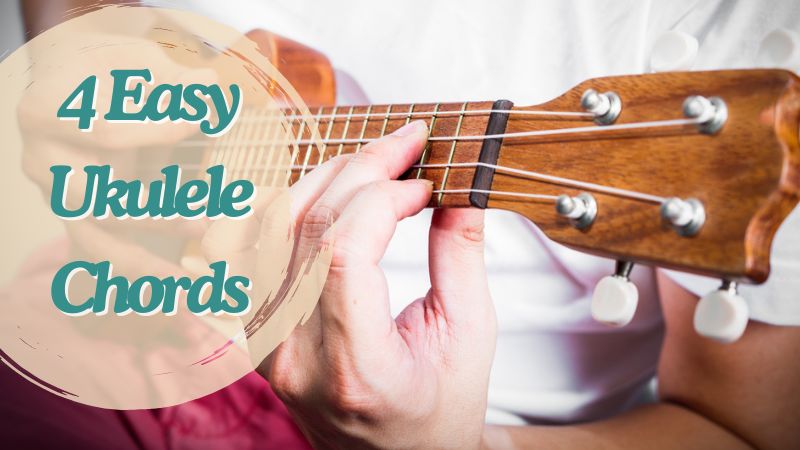These basic ukulele chords are your key to being able to play many songs, both beginner and intermediate, on your uke.
Written by Jay Searle / Published December 11, 2023
Last updated: April 09, 2024

Ukulele chords are essential for musicians who wish to cover their favorite songs or write their own, but they’re equally important for jamming, improvising, and noodling around.
There are well over 100+ unique ukulele chords, but by learning just a few basic ones, you’ll be able to play most mainstream songs and follow other musicians in jam or songwriting sessions.
In this article, we’ll break down some of the most basic chords on the ukulele and give you a few tips about how to make use of them.
Ukulele Chords 101
This section is dedicated to explaining what ukulele chords are, how to hold an ukulele, and how to play your first chord. Even if you have some experience with a guitar or bass, ukulele chords are unique, and first-time players could greatly benefit from understanding the essential concepts of uke chord play.
What Are Ukulele Chords?
Music chords are combinations of pitches (notes) that form a unique tone when played simultaneously. In the case of ukulele chords, these can be combinations of 3 or 4 notes; contrary to the popular misconception, two-note combinations aren’t chords – they’re called “dyads” or partial chords.
Basic Ukulele Chord Glossary
Uke chords are comprised of notes or pitches. They’re sonic representations of the tones you play expressed in audio frequencies. When a string is plucked or strummed, whether it’s open or fretted, a vibration is produced. These vibrations pulsate at specific frequencies, which are augmented by the ukulele’s tonewoods before coming out as a “final product” in the shape of a tone.
All chords, ukulele chords included, are based on a “root note.” This is the note that defines the chord’s tonality and is usually the note after which the chord is named. Moreover, the root note is usually the lowest note in the chord. For example, the G Chord starts with the lower G note. This is not a rule, though. Certain inverse chords, for instance, feature opposite root positions.

The “distance” in pitch between the root note and all other notes in a ukulele chord is measured in “intervals.” If all notes in a chord are played simultaneously, these intervals are called “harmonic intervals”; if, for example, you’re playing an arpeggiated chord (one note at a time), you’d be playing “melodic intervals.”
Upstrokes and downstrokes are important terms for beginners learning how to play ukulele chords. They tell us the direction of the plucking of a certain chord, or in other words, the plucking order of individual notes. All chords, ukulele chords included, are based on a “root note.” This is the note that defines the chord’s tonality and is usually the note after which the chord is named.
How to Play Ukulele Chords?
Ukulele chords are played by simultaneously playing at least three notes on the instrument. These notes can be “fretted” or pressed, or “open”, meaning that only the string should be played without pressing any frets.
One of the reasons why the ukulele is perfect for beginners is that there are many chords that feature open notes. For instance, to play the C Chord, you only need to press the note C (third position on the A string) while plucking the remaining strings.
Basic chords on the ukulele can be played with downstrokes or upstrokes – the player can flexibly choose either of the two or alternate between them as the song’s tempo and the specifics of the chord progression demand.
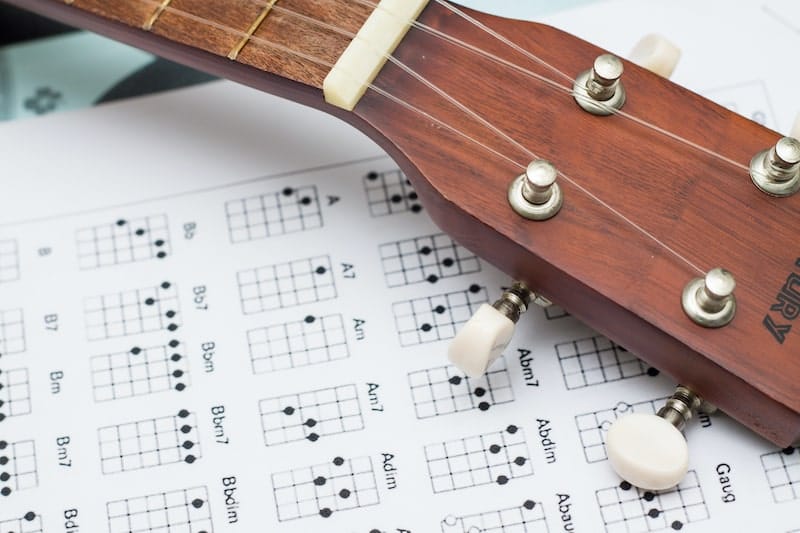
What is a Ukulele Chord Progression?
Just like a combination of (specific) notes creates a chord, a combination of chords creates a chord progression, which some musicians refer to as “harmonic progression”. It’s a line of ukulele chords played in succession in the desired tempo and key.
Uke chord progressions tell us the “order” of chords in a specific song or a music piece. Whenever you open a ukulele tab, you’re looking at illustrated chord progressions.
Basic Ukulele Chords Hand Positions
Fundamental ukulele chords are referred to as “basic” chords for two reasons. Firstly, they’re not technically demanding and most people can learn them relatively quickly. Secondly, most songs can be played using the same 4-5 ukulele chords. In this section, we’ll cover the most important basic uke chords and help you learn how to play them.
C Ukulele Chord
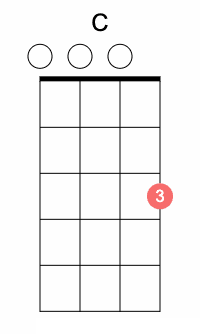
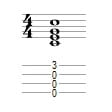
Arguably the simplest chord you can play on the ukulele, the C Chord blends the innate harmony of the open G, C, and E strings with the mellow-sounding C in the third position of the A string.
For songwriters, the flexibility of the C Chord can be used to open or close the tune while beginners can easily prepare for upcoming chords in the progression due to its simplicity. To play the C Chord on your ukulele follow these steps:
- Place your ring finger on the 3rd fret of the A string
- Leave the G, C, and E strings open
- Pluck all the strings
A Ukulele Chord
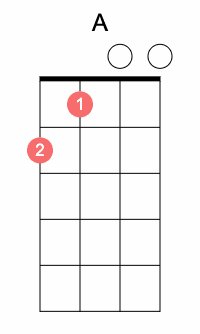

The A Chord rivals the simplicity of the C Chord but it tends to be just slightly harder for beginners since it needs you to use two fingers instead of one. It’s comprised of the root A in the second position of the G string; a 2nd interval C# in the first position of the C string, and open E and A strings.
Compared to other essential uke chords, the A Chord has an almost “neutral” tone that is ideal for backing ukulele melodies or other instruments. To play the A Chord, just do the following:
- Place your middle finger on the 2nd fret of the G string
- Place your index finger on the 1st fret of the C string
- Leave the strings E and A open
- Strum all four strings
Am Ukulele Chord
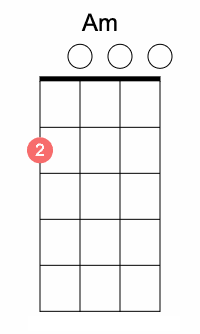

One of the most common variations of the A Chord is the A Minor (Am) Chord. It’s played almost exactly the same as the A Chord, only instead of pressing the first fret of the C string, you should leave it open (like E and A strings).
By replacing the note C# with a C, the character of the entire chord shifts from a neutral sound to a more melancholic atmosphere. This is easily one of the most commonly used ukulele chords in ballads, although it’s seen its fair share of use in classical music as well. Follow these steps to play the Am Chord:
- Place your middle finger on the 2nd fret of the G string
- Leave the strings C, E, and A open
- Pluck the strings
G Ukulele Chord
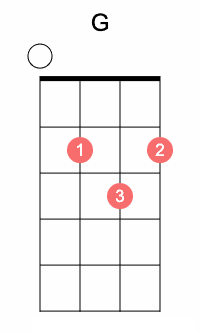
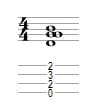
The “trickiest” of the essential ukulele chord assortment is the G Chord, simply because you’ll be using three fingers.
This chord can be difficult for some beginners since there are two notes that need to be pressed in the same position – the D on the C string, and the B on the E string. The easier way of pressing them both with minimum effort is to simply extend your index finger above the entire fret, forming the so-called “bar chord” over both notes.
Since many newcomers don’t have the dexterity to efficiently use bar chords without compromising the sound quality of the played chord, we recommend following the traditional route by using these steps to play the G Chord:
- Press the 2nd fret on the C string with your index finger
- Press the 2nd fret on the A string with your ring finger
- Press the 3rd fret on the E string with your middle finger
- Leave the G string open and strum
Beginner Ukulele Chord Technique Tips
Every ukulele chord is simple if the coordination between the fretting and the strumming hand is seamless. The reason why some first-time uke players struggle with certain ukulele chords is that they have to think about multiple things at the same time while experienced players can rely on muscle memory.
We’ve dissected the basics of ukulele chord techniques for each hand, hoping that these tips will help you tackle any chord with ease.
Strumming and Fretting Hands Explained
Whether you’re a right or left-handed person is irrelevant – the strumming hand is the hand you use to pluck the strings (right for right-handed, and vice versa) while the fretting hand is the hand you use to press the notes (left for right-handed, and vice versa).
You will eventually build a varied arsenal of skills and techniques for your strumming hand – from fingerstyle picking to using a pick to the so-called “hybrid” picking that combines them.
The fretting hand is pressing the notes on the frets, hence the name. Even if it seems intuitive, refrain from using your thumb to press the notes – all of your other fingers will have different jobs, depending on which chord you’re playing.

Fingerstyle Strumming vs Plucking
The term strumming refers to a technique where you’re using your fingernails as impromptu guitar picks. Plucking, on the other hand, refers to pulling the strings with your fingertips. Each technique has different applications, merits, and drawbacks.
For example, strumming is far more convenient for chord play since you can reach all four strings quickly. On the other hand, you’ll need to find the right size for your nails so that they don’t hurt or accidentally touch the strings you don’t want them to.
Plucking is better suited for arpeggiated scales and chords – picking one note at a time. Using your fingers instead of nails will also produce a different type of sound, so experiment with both until you find the technique that suits your preferences.
Final Words
Learning essential ukulele chords is not mandatory by any means – you can still play chords and songs even if you don’t know what they’re called.
However, learning ukulele chords will help you memorize what you’re doing; you will cover songs faster, not to mention that playing with others will become significantly easier. We hope that our guide to basic ukulele chords helped you improve your understanding of what you can do on a ukulele.

Jay Searle
Website Founder & WriterJay is a self-professed music nerd and ukulele lover. When not working on the website you’ll find him strumming along to his favorite tunes, spending time with his family, or learning to play the piano.

